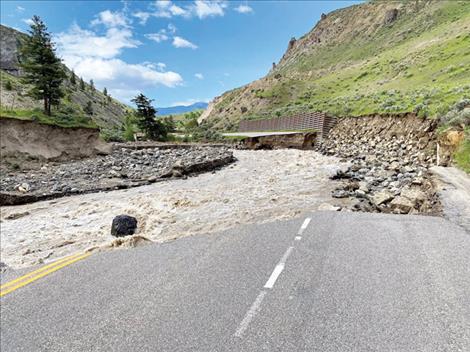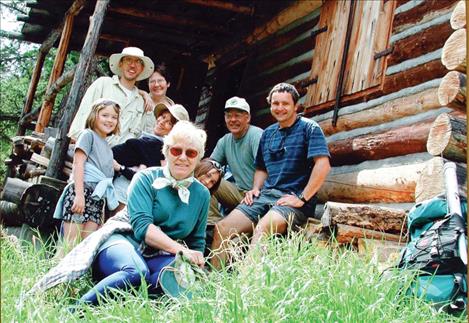Yellowstone flooding hits home
Hey savvy news reader! Thanks for choosing local.
You are now reading
1 of 3 free articles.
When the Yellowstone River leapt out of its banks Monday morning, Polson resident Dayna McClure was in Gardiner with a group of friends and retired Yellowstone Park employees who call themselves the Ladies Hiking Group.
The first she heard of the massive flooding was a text from her daughter, Erin. “I guess you’re not going anywhere,” the text read. “I said ‘what are you talking about?’”
Outside the door of their vacation rental, where it had been raining steadily since Sunday morning, the river had already collapsed portions of the five-mile stretch of road leading into Mammoth Hot Springs from Gardiner. As McClure and her friends watched, it was busily gnawing away the foundation of a house rented by park employees, which eventually toppled into the river.
The hiking group and thousands of others evacuated from the park were stranded in Gardiner until Tuesday, when a slow-moving caravan headed north on Hwy. 89 to Livingston, traversing parts of the road that were inundated with three feet of water just the day before.
They passed the spot where the steel-truss Carbella Bridge on Tom Miner Creek Road had washed away early Monday. “Our son used to jump off the top of that bridge,” McClure recalled.
Behind them, the town where Dayna and her husband, Craig, spent 26 years was hemorrhaging its lifeblood: the tourists who swell its population each summer and winter, sustaining the guides, restaurants, motels and vacation rentals that keep its economy afloat.
A friend told Dayna that what’s left “feels like a ghost town.”
The McClures, both retired Park Service employees, raised their two children in Gardiner, living in a historic cabin just inside the park boundary. As an engineer, Dayna supervised the road crew for four years, ,worked in the maintenance division, and oversaw the facility management program which inventoried “every built thing in park,” from 1,000 miles of trail to culverts, bridges, roads, and water and sewage treatment plants – many of them impacted by last weekend’s flooding.
Craig was a park ranger whose duties ranged from law enforcement to resource management. They were on hand for the fires of 1988 that ravaged 75% of the park.
“That was so devastating but not on the scale that this is,” Dayna says. “Things burned, but they came back. This is going to have such an impact for many years. Just the debris left in the Yellowstone River will be there for decades.”
Their children, Erin and Gavin, were once raft guides on the Yellowstone. “They knew the name of every rapid – Queen of the Water, Sleeping Giant,” she says. “The put-ins and take-outs are gone. That’s going to be a whole new river.” Those changes will no doubt impact raft companies and fly-fishing guides that ply the the Yellowstone from May through October.
McClure says a family friend who owns a wolf-guiding business that takes tourists into the Lamar Valley may lose a season too, since the north entrance to the park is closed indefinitely. The road from Gardiner to Silver Gate and Cook City through Lamar Valley is typically accessible year around and serves as the only plowed thoroughfare during the winter months. Its continued closure would strand residents in those tiny mountain towns.
The flood washed away swaths of the highway between Gardiner and Mammoth, causing mud and rockslides, claiming a bridge and crumbling asphalt into the river. That’s in addition to damage inside the park that forced the evacuation of 10,000 visitors and closed all five entrances.
Rain, which is already 400% above average for June, drenched the area, falling on top of recent snow. The combination propelled stream flows in the river as high as 51,000 cubic feet per second – that’s roughly 20,000 cubic feet per second more than the high recorded in the 1990s.
Now, the Park Service “will have to triage and decide ‘what are we going to do, where are we going to spend the money,’” Dayna says.
Among the myriad complications: the park’s laundry services are located in Gardiner, and its headquarters are in Mammoth. The road closure also impacts the many seasonal park employees who rent or own homes in Gardiner.
“It’s just going to add another level of challenge for folks during the busy tourist season,” says Craig. “I think we’re very fortunate we have a good management team down there. They’ll try to do whatever they can … It’s just going to take some time.”
In an announcement Friday, the National Park Service said the park’s southern loop will open June 22 allowing limited access to Madison, Old Faithful, Yellowstone Lake, Norris and Canyon Village. The press release also said the park is working to reconnect Mammoth Hot Springs to Gardiner and Cooke City/Silver Gate “as soon as possible with temporary solutions, while long-term reconstruction is planned.”
A personal loss for the McClure family was the historic Lower Blacktail Patrol Cabin, built in the 1920s at the convergence of the Yellowstone River and Blacktail Deer Creek. The cabin, demolished by the flood, had been a favorite hiking destination for the McClure family and many park employees. Dayna’s hiking group was there last August, and Craig helped rescue it from the fires of 1988.
“It’s such an iconic piece of our history, our memory,” Dayna says.
The couple shares a deep concern for the immense park and the community on its edge that they know so well. “It’s just being isolated and stranded that’s really going to hurt,” says Dayna of her former hometown.
“Groups are pulling together to help support folks,” adds Craig. “But what they really need is business.”


















